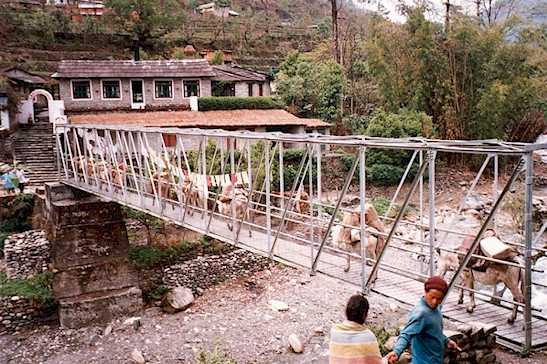Peace Corps Nepal Programs by three volunteers
Peace Corps Online:
Directory:
Nepal:
Peace Corps Nepal :
Web Sites for Nepal RPCVs:
Peace Corps Nepal Programs by three volunteers
Peace Corps Nepal Programs by three volunteers

Peace Corps Nepal Programs by three volunteers
Peace Corps Nepal Programs
Peace Corps Nepal has been a part of Peace Corps since its second year of existence (1961). These days there are roughly 150 peace corps volunteers in the country at any given time. Several different programs are ongoing including fields in drinking water, soil conservation, nursing, community developement, urban development, forestry, fisheries, and others. Sometimes certain programs are terminated and other begun. For a up-to-date list of peace corps programs active today contact Peace Corps (http://www.peacecorps.gov) or write the country director of Nepal at
Country Director
Peace Corps Nepal
GPO box 613
Tej Bhawan, Lazimpat
Kathmandu, Nepal
Since the three volunteers who put together this site worked in drinking water supply and soil conservation, those fields have been desribed in brief below.
Water Supply in Nepal
Water supply in Nepal is a very interesting topic to talk about. Because of the remoteness of many projects combined with the lack of proper funds for the district water supply offices and a hand full of other reasons, the data collection for potable water coverage in Nepal is uncertain. Official figures put the total urban coverage about 60% and rural coverage about 40%. These figures are greatly exaggerated in my opinion, mainly due to the indirect motivation for inflated reporting by the district water supply officers and their superiors, all the way to the top. Job performance and effectiveness is (as in most countries) tied directly to the numbers. And if the numbers look good the person looks good. This should not be looked at in a negative way but rather it is insight into the numbers and what they mean.
In actuality, the numbers can be as low as 50% off the tabulated values as estimated by certain individuals (including my experience). But because there is no easy way as of yet to gather this information, no one really knows what the actual numbers are.
There are three main types of water projects in Nepal. They are the gravity flow community water supply projects commonly referred to as just "gravity flow" projects, spring protection projects, and the tube well projects.
Both gravity flow and spring protection projects are projects that are used in the hill regions of Nepal. They rely on gravity as a means to move the water from point A to point B. As a result, both systems are very similar in design. The main difference lies in the length and complexity of the scheme. Gravity flow projects cover up to 20 kilometers in length of pipeline where spring protection projects cover only about 10 meters in length. In other words, gravity flow projects aim at protecting the source and transporting the water as close as possible to the users and protecting the source. Spring protection only concerns itself with protection of the source, no transportation.
Tube well projects are the type of project used in the the Terai, the flatlands of Nepal. In the Terai, the watertable is readily accessible (unlike the water table in the hills which is not practically accessible). The other advantage to projects in the Terai is that most locations can be reached by vehicle, making the use of well drilling equipment (a necessity to tube well projects) possible.
Water project descriptions are for:
Soil Conservation Projects
Nepal is a mostly mountainous country with a three-month long monsoon season. Approximately 95% of the population are farmers. Almost all homes rely on their personal livestock to provide the fertilizer needed to grow their crops. A system of terracing the mountainsides has evolved from centuries ago to allow farmers to make use of their land. But as the population has grown, farmers must produce more from what little land they have. The Soil Conservation Department of the Nepali Government, along with NGOs, have been bringing advanced and efficient agricultural concepts to the people to allow them to better utilize their land. Most farmers cannot afford chemical fertilizers and those that can usually do not use them efficiently. Preserving the fertility of the soil is a necessary objective to improving the quality of life for farmers in Nepal.
Some soil conservation topics are:
Fodder
Level Terracing
Water Conservation
Community Planning
Smokeless Cookstoves
Gobar Gas
Check Dams

Some postings on Peace Corps Online are provided to the individual members of this group without permission of the copyright owner for the non-profit purposes of criticism, comment, education, scholarship, and research under the "Fair Use" provisions of U.S. Government copyright laws and they may not be distributed further without permission of the copyright owner. Peace Corps Online does not vouch for the accuracy of the content of the postings, which is the sole responsibility of the copyright holder.
Story Source: Personal Web Site
This story has been posted in the following forums: : Headlines; COS - Nepal; Water Supplies; Soil Conservation
PCOL7198
78
.

